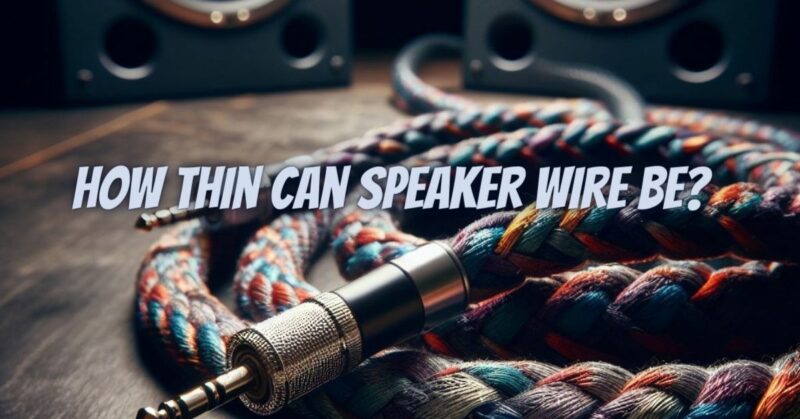Choosing the right speaker wire gauge is a crucial aspect of setting up an audio system. While thicker speaker wire is often favored for its low resistance and superior conductivity, it’s worth exploring how thin speaker wire can be without compromising audio quality. In this comprehensive article, we will delve into the limits of speaker wire gauge, discussing the factors that influence the choice of thin wire, potential applications, and considerations for maintaining performance.
Understanding Speaker Wire Gauge
Speaker wire gauge is typically measured using the American Wire Gauge (AWG) system, where lower numbers represent thicker wire. Common speaker wire gauges range from 10 AWG (thick) to 18 AWG (thin), with 16 AWG and 14 AWG being standard options.
Factors Influencing the Choice of Thin Speaker Wire
The selection of thin speaker wire depends on several factors:
- Distance: For shorter cable runs, thinner wire can be used without significant signal loss. However, longer cable runs may require thicker wire to counter increased resistance.
- Amplifier Power: Lower-powered amplifiers can work well with thin wire, as they generate less current. High-powered amplifiers benefit from thicker wire to minimize resistance.
- Speaker Impedance: The impedance of your speakers plays a role. Lower-impedance speakers (e.g., 4 ohms) demand thicker wire to maintain signal integrity, while higher-impedance speakers (e.g., 8 ohms) can tolerate thinner wire.
- Application: The intended use of your audio system matters. Background music setups, low-volume listening, or casual setups may not require thick wire. However, critical listening environments and high-end systems often benefit from thicker wire.
How Thin Can Speaker Wire Be?
Speaker wire can theoretically be as thin as the smallest commercially available gauge, which is typically around 18 AWG or even 20 AWG. However, the choice to use such thin wire depends on several considerations:
- Signal Loss: As wire gauge increases (becomes thinner), resistance also increases. Thinner wires have higher resistance, leading to signal loss. Over longer cable runs, signal loss can become more pronounced.
- Audio Quality: Thinner wire may compromise audio quality, particularly at higher volumes or with high-resolution audio sources. Loss of detail, reduced dynamics, and a diminished sense of depth can occur.
- Power Handling: Thin wire may not effectively handle the power output of high-powered amplifiers, potentially leading to distortion, overheating, and damage.
- Speaker Compatibility: Ensure that the wire gauge chosen is compatible with your speakers’ power handling capabilities. Using wire that is too thin for your speakers’ requirements can lead to issues.
Applications for Thin Speaker Wire
While thinner speaker wire is generally associated with shorter cable runs and lower-powered systems, it can still find practical applications:
- Background Music and Paging Systems: In situations where audio quality is not critical, such as background music in retail spaces or paging systems, thin wire can be suitable for connecting speakers over short distances.
- Low-Volume Listening: If you primarily listen at low volumes, the impact of signal loss due to thin wire may be minimal, making it a cost-effective choice.
- Budget Constraints: Thin speaker wire is typically more budget-friendly than thicker options, making it an option for setups where cost is a significant consideration.
- Temporary or Portable Systems: Thin wire can be more convenient for temporary or portable setups where ease of installation and transportation are priorities.
While speaker wire can technically be as thin as commercially available options like 18 AWG or 20 AWG, the choice to use thin wire should be made with careful consideration of the specific requirements of your audio system. Thinner wire may be suitable for background music, low-volume listening, budget-conscious setups, and temporary installations. However, it’s essential to balance cost savings with the potential for signal loss, audio quality degradation, and compatibility with your amplifier and speakers. In critical listening environments or high-end audio systems, it is generally advisable to opt for thicker wire to ensure optimal signal transmission and audio quality. Ultimately, the choice between thin and thick speaker wire should align with your system’s needs and your listening preferences.


